
by Sara E. Pratt Thursday, January 29, 2015

Naturally occurring asbestos has been found in and around Boulder City and Henderson in southern Nevada, including in many desert areas popular with mountain bikers, hikers, horseback riders and recreational vehicle users. Boulder City lies about 30 kilometers southeast of Las Vegas and west of Lake Mead, seen here. Credit: ©Prayitno, CC BY 2.0.
In 2011, Brenda Buck, a medical geologist at the University of Nevada, Las Vegas (UNLV), was studying the human health effects of mineral dusts at Nellis Dunes — a 40-square-kilometer area northeast of Las Vegas that is popular with off-road enthusiasts, 300,000 of whom visit the dunes each year.
Buck was looking at how much natural arsenic was being mobilized in the clouds of dust kicked up by all-terrain vehicles when she found something else in her samples of airborne dust: palygorskite, a fibrous clay mineral that has been found to be carcinogenic in some studies, although not in others.
The discovery raised the troubling question of whether residents of Clark County, Nev., were being exposed to potentially carcinogenic minerals. Buck contacted Francine Baumann, a cancer epidemiologist at the University of Hawaii Cancer Center who specializes in studying malignant mesothelioma clusters caused by environmental exposures to fibrous minerals, including needle-like fibers associated with asbestos.
People can be exposed to mineral fibers in multiple ways, including ingestion, but inhalation is the main pathway. If inhaled, mineral fibers, particularly long, thin ones, can lodge deep in lung tissue and can migrate to other organs and tissues in the body, even crossing the placenta. Asbestos-related diseases include lung, ovarian and larynx cancer and mesothelioma, or cancer of the lining of the chest cavity, as well as cardiovascular and autoimmune diseases such as rheumatoid arthritis, Lupus and scleroderma.
Baumann requested cancer data for Clark and nearby counties from the Nevada Central Cancer Registry (NCCR), and her analysis found more women and young people in Clark County with mesothelioma than would be expected in the general population.
Mesothelioma is rare. According to the Centers for Disease Control and Prevention, about 2,500 people in the U.S. die from it each year. The disease also has a long latency period; it can take 20 to 40 years or more to develop. About 80 percent of deaths each year are men, most of whom were exposed to asbestos decades earlier in construction, mining or industrial jobs.
The discovery of more young people and women than expected with a disease that usually strikes older men suggested to Baumann that an environmental source of fibrous minerals, rather than an occupational exposure, may be present in Clark County, which would warrant further investigation.

The amphibole minerals magnesio riebeckite, richterite and winchite have been found in Arizona, as well as in Libby, Mont. Credit: Rodney Metcalf.
When Buck heard the results, she consulted her UNLV colleague, geologist Rodney Metcalf, who studies the volcanic-plutonic complexes of the northern Colorado River extensional corridor south of Las Vegas. “I told him, ‘I think we have a problem,’” Buck says. “‘I think people are being exposed in Nevada.’” Together, they began searching for outcrops that could be the source of the fibers, both in southern Nevada and across the border, on the other side of the Colorado River, in Arizona, where a student of Metcalf’s had found fibrous minerals in the late 1990s.
What they found surprised them: fibrous amphibole minerals — asbestos — in a geologic environment and rock type not previously associated with it. “There are only five or six environments that were known to produce asbestos,” Metcalf says, “and none of them are in southern Nevada.”
The implications of the discovery reach beyond Nevada and Arizona. “There could be other communities that are being exposed and they don’t even know it,” says Buck, who is director of the Environmental Soil Analysis Laboratory at UNLV.
At the moment, however, Buck and Metcalf are most concerned about the asbestos-containing rocks that have already been found locally. They lie in close proximity to schools and residential areas, and are directly in the path of a planned major highway construction project. Buck, an avid horseback rider, also discovered the tiny fibers on her clothes, shoes, horse and car tires after riding on a dirt road near Boulder City, a town of 15,000 people about 30 kilometers southeast of Las Vegas in Clark County.
“Boulder City is built on it,” Buck says of the bedrock found to contain asbestos. And it “can be eroded, washed by water and blown by wind, so the actual footprint is much larger.”
In the years since the discovery, the series of events that unfolded, including the response of the state department of health, has left the scientists wondering whether the public is being adequately informed of the potential risks, or if the research needed to elucidate that risk will ultimately be done.
One of the challenges of dealing with asbestos is that there is no single definition of what it is. In general, it is a class of minerals with thin, fibrous crystal habits belonging to two families: the serpentines, which have a sheet-like or layered crystal structure, and the amphiboles, which have a chain-like structure.

Scanning electron microscopy images of mineral fibers found in Nevada and Arizona, some of which are similar in size and crystal habit to those found in Libby, Mont. Credit: all: Brenda Buck and Rodney Metcalf.
The minerals form only in specific rock types and under certain geologic conditions that promote the growth of fibers, usually via the chemical alteration of magnesium-rich rocks by hydrothermal fluids. The most common asbestos-forming rocks are ultramafic rocks that have been metamorphosed under relatively low heat and pressure.
Beginning in the mid-19th century, asbestos minerals were widely used as fire retardants. Other materials — yarn, cloth, cement and bricks — were impregnated with asbestos fibers for use in fireplaces, flooring, pipe coatings, gaskets, drywall and building insulation among other uses. By the 1970s, the health impacts of asbestos were becoming better known, and the amphiboles were recognized to be the more hazardous type.
When most asbestos use was banned nationwide in 1989, however, only the six minerals that had been most commonly mined and used commercially were legally defined as “asbestos” and regulated. These included one serpentine mineral, chrysotile, and five amphiboles: actinolite, anthophyllite, cummingtonite-grunerite (known commercially as amosite), riebeckite (known commercially as crocidolite) and tremolite.
Yet scientists have identified nearly 400 naturally occurring fibrous minerals. Many are not dangerous, but some clearly are, and only a handful of them have been studied.
“We just weren’t thinking about exposures to natural occurrences back then,” says Bradley Van Gosen, a geologist at the U.S. Geological Survey who has mapped all known, natural occurrences of asbestos in the lower 48 states. “We were only thinking about the asbestos that was used commercially in products.”
Thus, most other asbestiform minerals remain unregulated. Meanwhile, evidence has accumulated that some natural occurrences of asbestiform minerals are equally as hazardous as commercially used asbestos.
One such mineral is erionite, which was responsible for an epidemic of mesothelioma deaths, first identified in the 1970s, in the Cappadocia region of Turkey, where villagers had built their homes out of erionite-bearing rock. In some villages, 20 to 50 percent of the deaths each year were due to mesothelioma, the highest rates of cancer related to an environmental exposure to toxic fibrous minerals ever reported. Erionite is also found in 13 U.S. states, including North Dakota, where, for roughly three decades until becoming aware of its toxicity in 2006, one county mined erionite-containing gravel for use on roads and other surfaces. A recent study of the chest X-rays of road workers and others exposed to the gravels in North Dakota detected early changes in lung tissue. Today, the use of gravel from the asbestos-containing formation has been restricted, some areas have been remediated, and the state has established guidelines to limit erionite exposure.
Other examples of unregulated asbestiform minerals are the amphiboles winchite, richterite and magnesioriebeckite, notably found in Libby, Mont., where for decades W.R. Grace and Company, and others before it, mined a vermiculite ore body that was contaminated with amphibole asbestos. The exfoliated vermiculite was used as attic insulation, sold under the brand name Zonolite, in tens of millions of American homes, including those in Libby. It was also used around town on gravel roads and as a soil amendment and landscaping material. Since the asbestos contamination came to light in the 1990s, the deaths of more than 400 Libby residents, mostly miners and their family members, have been attributed to asbestos-related diseases, mainly mesothelioma, and more than 1,700 other residents remain ill with asbestos-related diseases. In 2002, the town became one of the nation’s largest Superfund sites.
“Libby turned everything on its ear,” Van Gosen says. “Here are amphiboles that are asbestiform, but aren’t among the six regulated minerals, and yet are clearly toxic.”
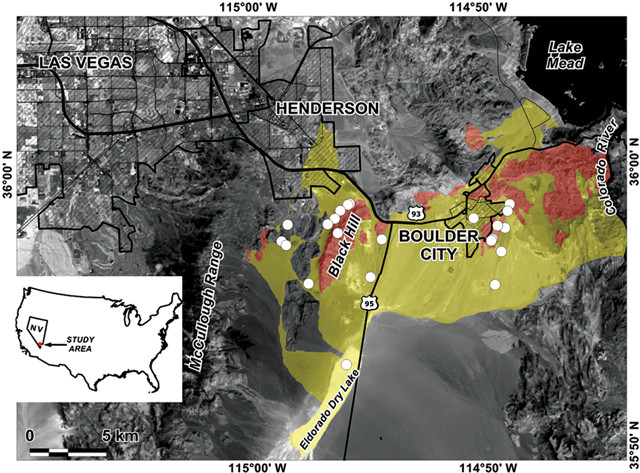
In this Landsat image of the study area in southern Nevada, granitic plutons are shown in red, estimated areas of alluvium deposited from erosion of those plutons are shown in yellow, and sampling locations are shown as white circles. All sampling locations contained fibrous amphiboles. Credit: Buck et al., 2013, Soil Science Society of America Journal.
In a November 2013 article in the journal of the Soil Science Society of America, Buck, Metcalf and colleagues reported their discovery in southern Nevada of actinolite, one of the regulated asbestos minerals. The researchers first found the fibrous blue and green amphibole mineral lining fractures in Miocene granitoid plutons in an area of the McCullough Range south of Las Vegas. Further investigation found the mineral was also in soil and dust samples, including those tracked back to the lab on pants, boots and car tires. Assuming the samples are representative, the researchers estimated that fibrous amphibole minerals could be present in the soil or bedrock covering at least 214 square kilometers around the McCullough Range, Black Hill, and in and around the towns of Boulder City and Henderson, Nev.
In another study published in January in Geology, Buck and Metcalf described a separate discovery in northwestern Arizona of the amphibole minerals winchite, richterite and magnesioriebeckite, which are unregulated. “Those are the same minerals found in Libby, Mont.,” Metcalf says.
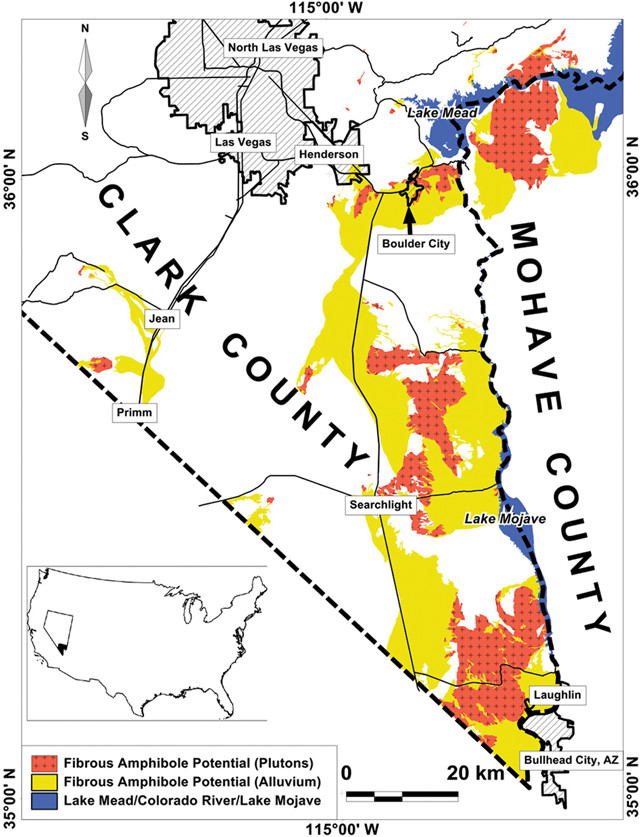
Predicted potential occurrences of fibrous amphiboles in Clark County, Nev., and an area of adjacent Mohave County, Ariz., south of western Lake Mead. Credit: Buck et al., 2013, Soil Science Society of America Journal.
The fact that the asbestos in Arizona shares a similar mineral composition to the asbestos found in the Libby vermiculite deposit “is somewhat unusual, given that they were formed in completely different geologic settings,” Van Gosen says.
Magnesium and sodium are both crucial to the formation of Libby-type amphiboles. Unlike in Libby, however, the asbestos source rocks in Arizona are granitic plutons, which intruded during the Miocene just as Basin-and-Range extension began, and were later uplifted during extensional faulting and exposed to groundwater flow.
“Granite is not a classic magnesium-rich rock, like other known occurrences [of asbestos-containing rocks],” Van Gosen says.
Buck and Metcalf proposed that the magnesium derived from magnesiohornblende within the granite plutons, which was scavenged by brines that infiltrated from evaporite deposits in nearby sedimentary basins, causing the mineral alteration between 13.7 million and 5.9 million years ago.
The discovery of a previously unknown type of asbestos-forming environment and host rock could help geologists — as well as municipalities, construction companies and transportation departments — locate other areas of potential risk in the future, Van Gosen says. “You could make a map, [comparing] similar rock units and similar geologic environments, that would show the potential for naturally occurring asbestos throughout the U.S.,” he says.
Funding is not currently available for such a project. However, Van Gosen plans to add the newly reported asbestos in Nevada and Arizona to the map of known occurrences.
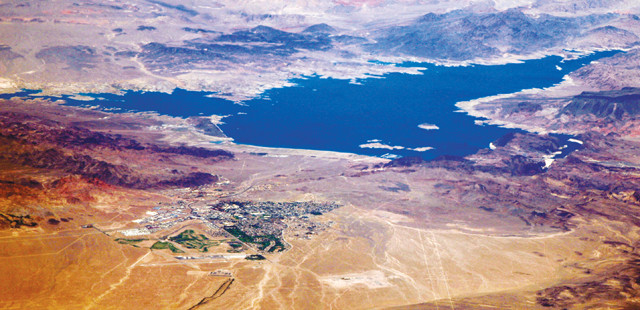
An aerial view of Boulder City, Nev., and Lake Mead. Hoover Dam is at right. The planned Boulder City Bypass will pass south of town through asbestos-containing rock and soil. Construction, which will include the blasting of roadcuts, is scheduled to begin in spring 2015. Credit: ©dsearls, CC BY 2.0.
Whether asbestos presents a health hazard depends on a number of factors. One is the aspect ratio — the ratio of length to width — of the fibers themselves. Longer, thinner fibers are more apt to lodge deep in lung tissue. But another factor is whether such fibers are ever mobilized in the first place. Weathering and erosion can release mineral fibers from the bedrock into the environment. Once there, they can be lofted into the air by wind, or mobilized by human activities like gardening, landscaping, driving and construction.
When Buck and Metcalf began searching for naturally occurring asbestos in Clark County in 2011, the Boulder City Bypass — a $490 million highway construction project to help develop an interstate connection between Las Vegas and Phoenix — had already been in the planning stages for about a decade. The project plan consists of two phases. The first, managed by the Nevada Department of Transportation (NDOT), will improve a roughly 5-kilometer section of U.S. Highway 93, which currently runs through downtown Boulder City, causing traffic congestion. And the second, managed by the Regional Transportation Commission of Southern Nevada (RTC), is a more than 19-kilometer portion of a new interstate, to be called I-11, which will bypass the city to the south.
Phase 1 construction was scheduled to begin in spring 2014. However, after the asbestos was discovered, construction was delayed until rock, soil and air samples collected along both sections of the planned construction route could be tested by consulting companies hired by NDOT and RTC.
The final test results, released in fall 2014, found asbestos in all 150 surface and subsurface samples taken in the Phase 1 area, at levels less than 0.25 percent. In the Phase 2 area, 20 percent of 194 surface samples collected contained detectable levels of actinolite asbestos, and 1 percent of samples had asbestos levels above 1 percent. The consultants also collected and analyzed an additional 267 subsurface rock and soil samples, of which more than half contained detectable levels of asbestos and 12 samples contained more than 1 percent asbestos.
“Overall, the independently conducted soil and rock tests confirmed that NOA [naturally occurring asbestos] is present in the project areas, but NOA concentrations are generally low,” NDOT project manager Tony Lorenzi wrote in a handout distributed at a public informational meeting held in Boulder City on Oct. 21, 2014. Regarding the blasting of roadcuts, Lorenzi noted, “rock-cut areas were tested and found to have varying concentrations of NOA. However, NOA is bound within the rock structure, and therefore, is unlikely to contribute to airborne emissions.”
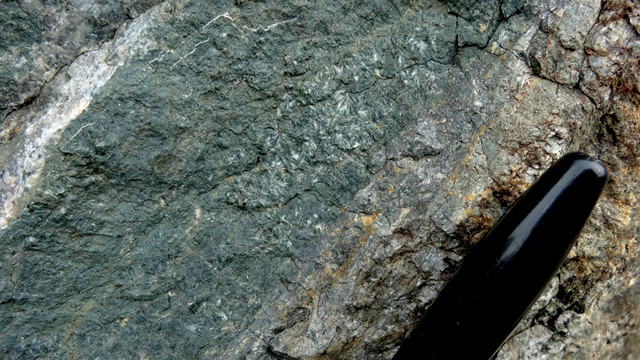
Actinolite asbestos, one of six fibrous minerals legally defined as asbestos and regulated as such, was found on the Nevada side of the border. Credit: Brenda Buck.
Currently, there are no regulations regarding NOA in Nevada, but there are in California, where NOA has been found at several sites. According to the California Air Resources Board, a material containing 0.25 percent or more asbestos is defined as a “restricted material,” which must be mitigated during construction and cannot be used as a surface material. Additionally, the Occupational Safety and Health Administration (OSHA) defines any material with 1 percent asbestos or more as an “asbestos-containing material,” which must be mitigated to reduce airborne emissions.
NDOT noted in the public informational handout that the regulatory limits are not based on, or indicative of, the actual potential health hazard.
Many factors affect whether asbestos fibers will become airborne, including the soil’s grain size and mineralogy, how wet or dry it is, how much organic matter and plant cover are present, the local wind speed and direction, and whether human activity, like gardening or construction, disturbs it.
“Unfortunately, there still is no accurate way to predict how much asbestos will be in the air based on how much asbestos is present in the soil,” Buck says. “This is really important to realize because people just assume that a low amount in the soil means it must be safer. This isn’t always true.”
In October, NDOT announced that construction of the Boulder City Bypass would begin in spring 2015 and would adhere to mitigation guidelines from the California Air Resources Board. These guidelines include spraying water on work sites to suppress dust, having construction workers wear masks and monitoring ambient air samples during construction.
According to OSHA, there is no “safe” level of exposure for any type of asbestos fiber. However, OSHA does set regulatory limits for the safety of workers doing abatement work, such as removing asbestos from old buildings. The maximum exposure is 0.1 fibers per cubic centimeter of air inhaled during a 40-hour workweek, which OSHA calculates will result in an additional 3.4 deaths per 1,000 workers over a working lifetime, a risk the agency deems “significant.”

Dust generated by a single off-highway vehicle driving in the desert west of Boulder City, Nev., toward the dry lakebed in Eldorado Basin, a popular site for recreational vehicle use. Credit: Brenda Buck.
Most asbestos regulations focus on workplace exposures; there are few guidelines for ambient environmental exposures. However, in December, the EPA released its final toxicology report on Libby, Mont., which included exposure-response analyses and established a reference dose, defined as “an estimate (with uncertainty spanning perhaps an order of magnitude) of an exposure that is likely to be without an appreciable risk of adverse health effects over a lifetime.” (Appreciable risk is defined as a 10 percent increase in the risk of developing adverse health effects, and a lifetime is assumed to be 70 years.)
The reference concentration established by EPA for noncancerous asbestos-related diseases (including asbestosis, pleural thickening, nonmalignant respiratory disease, cardiovascular disease and autoimmune disorders) for Libby-type amphibole asbestos fibers is 0.00009 fibers per cubic centimeter of air inhaled.
“It’s very concerning because what [the EPA report] says is not only should we be concerned about mesothelioma being a sensitive health effect, but maybe an even more sensitive health effect is this scarring of the lungs, which was found in people exposed to the amphibole asbestos in Libby, and which occurs at lower exposures than previously thought,” says Aubrey Miller, a medical epidemiologist and senior medical advisor at the National Institute of Environmental Health Sciences in Bethesda, Md., who investigated the mesothelioma cases in Turkey and Libby, Mont., as well as the health impacts of erionite exposure in North Dakota, and who has previously collaborated with Baumann. “If you find similar forms of mineral fibers in other locations, it would give one pause that it may be even more problematic.”
In Nevada, ambient air sampling conducted by NDOT consultants for three months in the summer of 2014 has provided a preliminary idea of how many fibers might already be in the air prior to construction of the planned Boulder City Bypass. Samples taken between May 8 and Aug. 9 at four stations near Railroad Pass in the Phase 1 section of the highway showed asbestos levels ranging from nondetectable to 0.014 fibers per cubic centimeter, with an average of 0.00021 fibers per cubic centimeter.
“What the NDOT report shows is that for three months over the summer, during a summer where we had significant rain, the average value at Railroad Pass was still an order of magnitude higher than this reference concentration,” from the EPA’s Libby report, Buck says. “This data suggests to me that the average Boulder City resident is probably breathing in, on average, higher concentrations than even this number.”
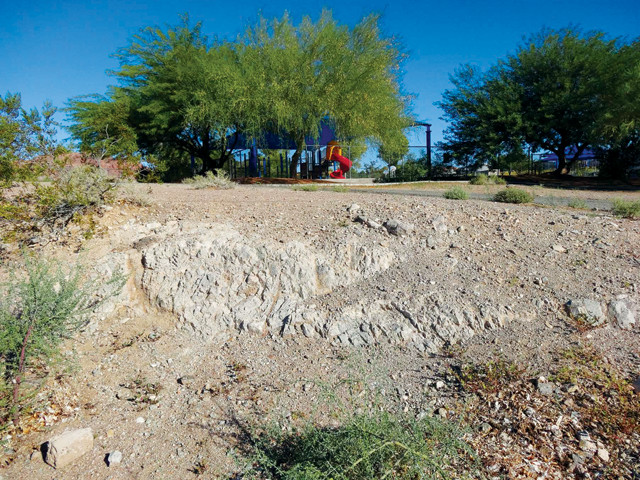
Asbestos was found in rock outcrops near developed areas, including residences and schools, in and around Boulder City, Nev. Credit: Brenda Buck and Rodney Metcalf.
Determining exactly how much of a health risk NOA might present to the local population will require further study, the researchers say. The first and easiest type of study typically conducted is a retrospective epidemiological analysis of the incidence of asbestos-related cancers in the local population, the type of analysis Baumann conducted in Clark County after she was first contacted by Buck.
In 2012, Baumann and colleagues, including Buck and Metcalf, submitted abstracts and intended to present talks on both the discovery of the new asbestos-forming geologic environment and the epidemiological findings at the annual Geological Society of America (GSA) meeting in Charlotte, N.C., in early November. One abstract caught the attention of a medical writer for the Journal of the National Cancer Institute who contacted Baumann and others, including the Nevada state epidemiologist Ihsan Azzam.
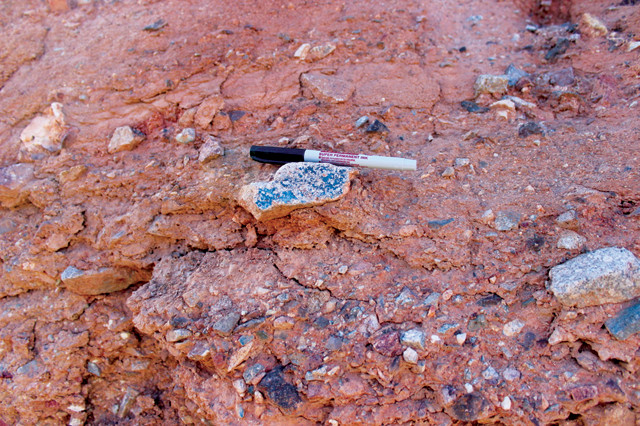
Amphibole minerals have been found in alluvium eroded from uplifted and weathered Miocene- aged plutons, which are shedding asbestos into the environment, particularly into alluvial fans and dry desert playas. Credit: Rodney Metcalf.
Alerted to the abstract by the reporter’s inquiry, the Nevada state health officer, Tracey D. Green, issued a cease-and-desist letter to Baumann disputing her findings and requesting that the GSA abstract be pulled from the program and the talk canceled. (In response, the researchers withdrew the abstract, plus a second abstract including epidemiological analysis based on the NCCR data of the incidence of malignant mesothelioma and lung cancer in southern Nevada. Only the geological findings were presented at the meeting.)
In the letter, dated Oct. 30, 2012, Green also denied further access to the researchers to the state’s cancer registry data because they had not sought her prior approval of the GSA abstract, violating the state’s “right of first refusal,” which she said Baumann had agreed to when requesting data from NCCR.
“Unfortunately, all of this could have been avoided had you choose (sic) to instead follow the appropriate protocol by engaging me and other NSHD [Nevada State Health Division] staff prior to rushing to publish and present. If you had of (sic) done that, we would have been able to discuss your ‘findings’ and collaborate with you to reconcile the discrepancies between your claims and the NCCR data,” Green wrote in the cease-and-desist letter.
Buck and Metcalf say they are still waiting for a response to an April 2014 letter they sent to NSHD asking to collaborate. (EARTH received no response to calls placed to NSHD, now the Nevada Division of Public and Behavioral Health.)
In February 2013, NSHD released a two-page fact sheet titled, “Mesothelioma in Nevada, 2000–2009,” which stated that the rate of mesothelioma per 100,000 residents is not elevated statewide and is comparable to other states nearby.
Although those claims are technically correct, Buck says, the epidemiological methods needed to tease out whether environmental exposures to asbestos may have caused disease require a finer-grained approach, and the use of statewide data overall wouldn’t accurately reflect the incidence in Clark County.
“Mesothelioma is very difficult,” Miller says. “It’s a bit like looking for a needle in a haystack because you’re looking for a very few number of cases within what tend to be small populations, but when you see cases of it, you need to look closer,” he says. What Baumann “has been trying to do is to look for any indicators in the population that say we should be looking closer, because we know that there is asbestos around.”
Additionally, “the absence of elevated mesothelioma levels doesn’t mean there isn’t any health risk,” Miller says. Due to mesothelioma’s long latency and the fact that exposures to asbestos-containing dust may have only begun with the more recent encroachment of roads and development, “we might not expect to see a bump yet in mesothelioma. It might be too early.”
“Even if the epidemiology is not showing [an increase] yet, it doesn’t mean that there won’t be one to come,” Miller says. “But they should really begin to take steps to make sure they don’t see one in the future.”
No further research on the potential public health hazard posed by the naturally occurring asbestos has been conducted by the state or any other researchers, and, due to the cease-and-desist letter, Baumann’s epidemiological analysis has not been published.
Buck says she suspects the cease-and-desist letter would not hold up if challenged in court. However, it was directed to the University of Hawaii and Baumann, who have chosen not to challenge it legally, she says, so it has continued to have a chilling effect on the research and public disclosure. (EARTH received no response to calls placed to Baumann.)
“Two years later, the public still doesn’t know what we think we know,” Buck says. “We need to go further with the epidemiological studies, but we can’t do that until we can get these preliminary data published.”
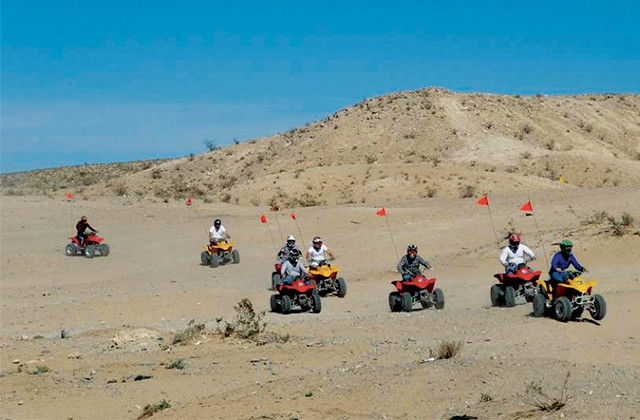
Nellis Dunes — a 40-square-kilometer desert area managed by the Bureau of Land Management 6 kilometers northeast of Las Vegas, Nev. — is a popular off-road-vehicle recreation area. The vehicles kick up dust carrying potentially hazardous mineral fibers, including asbestos, which was likely eroded from source rocks near Boulder City and deposited here by wind. Credit: Brenda Buck.
Beyond broad epidemiological surveys of mesothelioma occurrences, other types of medical studies could shed light on the potential public health risk in Nevada. These include cohort studies identifying people who had been exposed over decades. Examinations might include chest X-rays to detect precursory changes in lung tissue, which develop over shorter timescales and are detectable sooner than mesothelioma. Laboratory animal studies could test the carcinogenicity and immune suppression of the fibers.
Buck and Metcalf also want to conduct environmental studies, including measuring airborne mineral fibers and modeling how wind and water could be transporting the minerals in the environment, to help determine actual exposure levels for the public.
“We really need ambient air data,” Buck says. “We need to know what people are being exposed to.”
Another source of data may be the paleodust record, thousands of years of aeolian dust that lies buried under hardened biological crusts and desert pavements. “If you really want to understand human exposure, you also have to consider seasonal changes and changes with El Niño, so you have to look at more than one year, and you need to look at activities people do that increase exposure,” Buck says.
“We have a dry lake playa east of Boulder City, and it’s full of asbestos,” Buck says. “People go out and enjoy recreational activities, including driving off-road vehicles, which can greatly increase their exposure.”
The researchers also want to test for other types of asbestiform fibers, including erionite. “We haven’t confirmed erionite yet in the alkaline playas,” she says, “but I think it’s just a matter of time.”
© 2008-2021. All rights reserved. Any copying, redistribution or retransmission of any of the contents of this service without the expressed written permission of the American Geosciences Institute is expressly prohibited. Click here for all copyright requests.